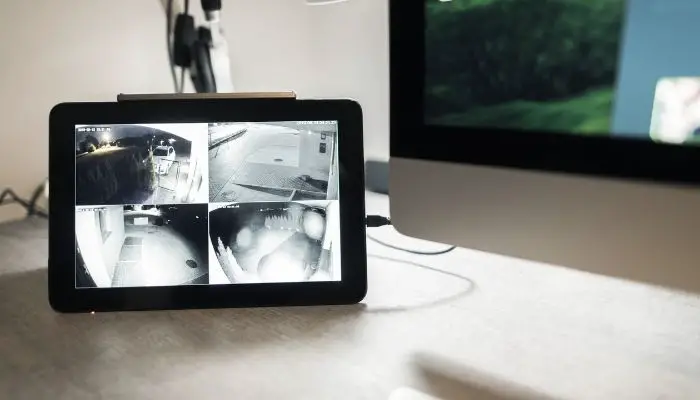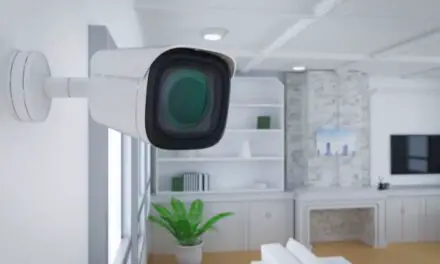Following Amazon’s acquisition of Blink in 2017, Blink cameras have become a staple in the smart home security camera marketplace.
They’re reasonably priced, packed with features, and very simple to install.
But how is battery life, and can you plug them in?
Table of Contents
Do Blink Cameras Have To Be Plugged In?

Except for the Blink Mini—which is a wired model—Blink cameras do not have to be plugged in to operate.
They are powered by lithium batteries that last up to two years.
Blink cameras have USB ports and come with a cable—albeit without a power adapter, for those who wish to plug it in.
However, plugging the Blink in doesn’t recharge the batteries.
Does The Blink Sync Module Need To Stay Plugged In?
Blink cameras—once again except for the Mini—are dependent on the Blink Sync Module.
Unlike the cameras themselves, the Sync Module does have to remain plugged in.
The Blink Sync Module actually extends the life of the batteries in Blink cameras, as it does most of the legwork, including:
- Providing local storage capability.
- Connects all of the Blink cameras—up to ten.
- Adds control via the Blink app (Android and iOS).
The Blink Sync Module connects to WiFi at 2.4GHz and is the primary access point for the Blink app.
For this purpose, it has to remain plugged in both to AC power and, for the fastest and most reliable use, a router’s ethernet port.
Why Plug In A Blink Camera?
If you find that the two-year battery life you were expecting from your Blink camera turns out to be more like three or four months, a power cord may be a better option than batteries.
As long as the camera isn’t too far from your home, you can plug in a long waterproof power cord that will extend to your camera and do away with the need for continuous battery replacements.
You’ll find waterproof cables that are 16ft plus in length and you could also add an indoor USB extension cable to get some extra length.
Many cables are also flat so they’ll look neat and go through your front door without you having to drill any holes.
Be careful to do lots of research and read plenty of customer reviews before you buy.
If the cable is too long or low quality, it won’t deliver the amperage needed to properly operate your Blink camera.
Are Blink Camera Batteries Rechargeable?
Blink camera batteries are not rechargeable, despite the optional USB port for wired power.
Blink Cameras use 1.5V AA Lithium batteries that are rated to last two years.
Not only do the batteries not charge when using the wired USB option, but they can also still drain and will not reflect an accurate battery summary by checking them through the Blink app.
Blink XT and XT2 cameras are designed to be waterproof.
When removing the rubber seal around the USB port for wired power, the weatherproofing feature is no longer under warranty and the device is subject to damage from rain and dust.
Unfortunately, there are several disadvantages to plugging Blink cameras in through the USB port.
The Blink Mini is the only camera in Blink’s lineup that is wired and not affected by these drawbacks.
Read Next: Why Is My Nest Camera Not Showing History? (Explained)
Can You Use Rechargeable Batteries In Blink Cameras?
Blink doesn’t recommend installing any old rechargeable batteries in Blink cameras.
The reason behind this is a matter of precise voltage requirements that rechargeable batteries may not provide.
While Blink isn’t very specific with their reasoning, some of the suggested issues that could arise from the use of rechargeable batteries are:
- Failure to access live streams.
- Complete failure.
- Severely shortened battery lifespan.
- Failure to communicate with the Sync Module.
In addition to their recommendations concerning rechargeable batteries, Blink also recommends Lithium batteries only, not alkaline.
Alkaline batteries are not as reliable as lithium and have trouble maintaining the voltage requirements that lithium batteries can.
Since rechargeable batteries are often Alkaline, the same reasoning applies across the board.
This includes Li-Ion, Ni-Cd, and Ni-MH batteries as well.
However, there is a rechargeable lithium battery pack that can extend the recording time of your camera by more than 50%.
This battery pack is made by Wasserstein and purpose-built to work with the latest Blink indoor and outdoor cameras.
You simply just charge it up and stick it on the back of your camera.
The pack has 4,400 milliamp hours of current which is significantly more than even the best batteries you can buy for your Blink camera.
It only takes two or three hours to charge and you can recharge it up to 200 times, so you’ll also be doing your bit for the environment.
Is The Battery Life Good On Blink Cameras?
Blink camera batteries are rated to last two years but how good you find the battery life to be will depend on how high traffic an area your camera is located, the length of clips you are recording, the definition you are recording in and the quality of batteries you are using in your camera.
To get the longest battery life, you should use the recommended Energizer Ultimate batteries.
Cheaper batteries will struggle to maintain the levels of high voltage that Blink cameras require and will run out much faster.
How often your camera is triggered will also impact battery life.
If your Blink camera is over your front door and is being triggered multiple times per day, you may not get much more than a year of usage before the batteries will need replacing.
However, if your camera is located in a lower traffic area and only being triggered a few times per week, then you may get the full two years battery life or even more.
Also, if your camera is positioned in a very high usage area, batteries may only last four or five months and may even die without giving you any warning at all.
If you set your camera to capture longer than usual or higher definition clips, it will also shorten battery life.
Can I Use Alkaline Batteries In My Blink Camera?
You can use alkaline batteries in your Blink camera and they shouldn’t damage your camera but you can expect to be changing or charging them very regularly (like as much as every 2 or 3 weeks).
Blink cameras require a pretty high battery voltage to function and the voltage in alkaline batteries drops off too quickly.
So after about two weeks, alkaline batteries will no longer be putting out the voltage required to run your Blink camera.
Can You Hardwire A Blink Camera?
The simplest answer is but you don’t have to.
The Blink Mini is already designed that way and all other Blink Cameras come with a USB option for wired power.
What is important to avoid, is damaging the XT and XT2 Blink camera models by removing the rubber cap protecting the USB port.
An open USB port is no longer resistant to the environment.
There are cables available if you’re looking for a wired option that will maintain the integrity of the XT or XT2.
There are USB power cables available that are designed to protect the weatherproof design of the Blink XT and XT2 for those who want a wired Blink.
If outdoor cameras aren’t a concern, Blink cameras come with an optional USB cable for wired usage, while a power adapter is sold separately.
Conclusion
So, do Blink Cameras have to be plugged in?
Only if dealing with the Blink Mini, which is a cute and highly reliable smart cam in its own right.
For all other Blink cameras, only plug them in if it’s practical.
Blink batteries are reliable and long-lasting. So long as you don’t replace them with non-lithium or other, rechargeable batteries, two years isn’t such a long wait.



